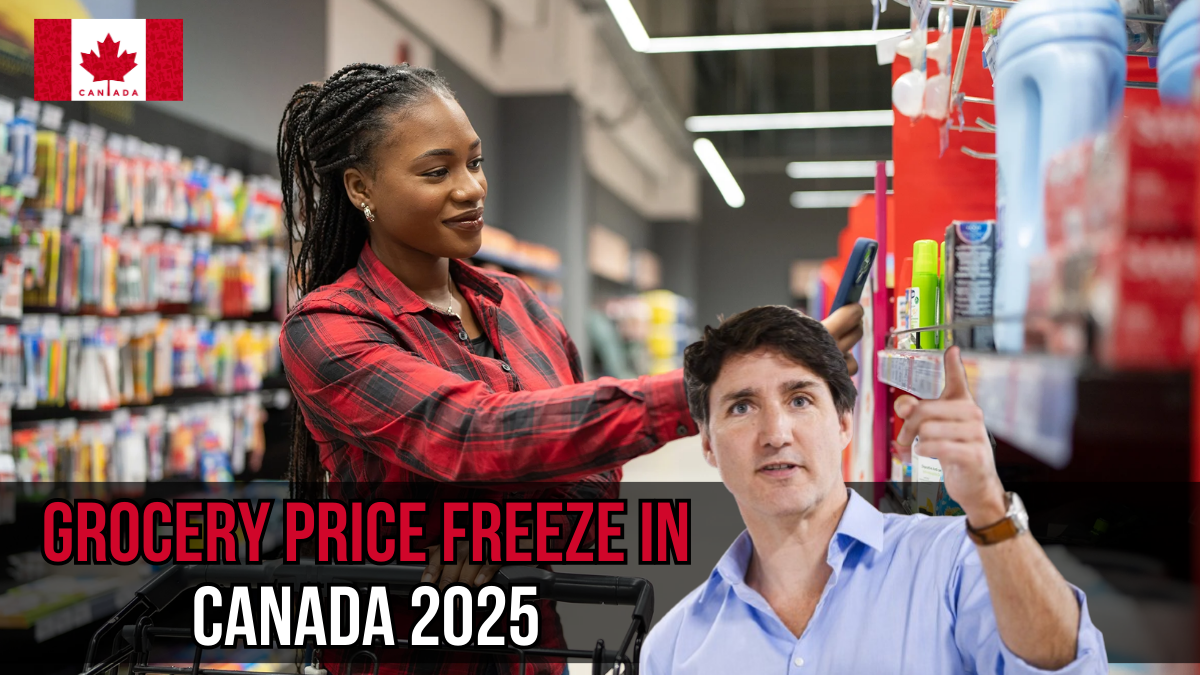The Government of Canada, in partnership with major supermarket chains, has announced a landmark Grocery Price Freeze beginning in September 2025. This initiative will lock prices on more than 1,000 essential food products for at least six months, providing much-needed relief for Canadian households struggling with the rising cost of living.

With food inflation reaching record highs in recent years, the program is seen as a direct response to public demand for affordability measures. For families, seniors, and students, the price freeze represents a significant step toward budget stability and consumer protection.
Why the Price Freeze Was Announced
Food inflation has been one of Canada’s most pressing economic challenges. Several factors contributed to soaring grocery bills:
- Global Supply Chain Disruptions – Ongoing impacts of the pandemic and shipping delays.
- Higher Production Costs – Rising fuel, fertilizer, and labor costs affecting farmers and producers.
- Climate Events – Droughts and floods disrupting local food supply.
- Inflationary Pressures – General economic inflation pushing retail prices upward.
The Grocery Price Freeze Announcement is designed to:
- Stabilize the price of basic foods like bread, milk, meat, rice, and produce.
- Provide targeted relief for low- and middle-income households.
- Restore consumer trust in retailers and food pricing policies.
- Reduce the financial burden on vulnerable groups such as seniors, students, and families with children.
Quick Summary-Canada Grocery Price Freeze 2025
| Detail | Information |
|---|---|
| Announcement | Federal Government of Canada with major supermarkets |
| Start Date | September 2025 |
| Duration | Minimum 6 months (until early 2026) |
| Coverage | Over 1,000 essential food items |
| Participating Retailers | Loblaws, Sobeys, Metro, Walmart Canada, Costco |
| Monitoring Authority | Competition Bureau of Canada |
| Scope | Staples, proteins, produce, pantry essentials |
| Official Website | Government of Canada – Competition Bureau |
Key Features of the Grocery Price Freeze
The government and participating retailers have confirmed several important details:
- Implementation Date: September 2025.
- Duration: At least six months, with possible extensions if required.
- Scope: Over 1,000 grocery products.
- Participating Chains: Loblaws, Sobeys, Metro, Costco, Walmart Canada, and other major supermarket groups.
- Monitoring: The Competition Bureau will oversee compliance.
- Transparency: Frozen-price products will be clearly labelled in stores to help consumers identify them easily.
Eligibility and Coverage
Unlike targeted subsidy programs, the price freeze is universal meaning all Canadians can benefit, regardless of income or background. Products covered include:
- Staples: bread, rice, pasta, milk.
- Protein Sources: chicken, beef, fish, eggs.
- Fresh Produce: fruits and vegetables.
- Pantry Items: flour, cooking oil, canned goods.
The goal is to cover the most widely consumed items forming the core of an average Canadian household’s diet.
How the Price Freeze Works
The program will operate in a straightforward manner:
- Retailers lock the price of selected products as of September 2025.
- Prices remain unchanged during the freeze period, regardless of supplier fluctuations.
- The Competition Bureau ensures compliance and prevents supermarkets from compensating by raising prices on non-frozen items.
- Consumers shop with confidence, knowing that essentials will remain stable in cost.
Benefits of the Grocery Price Freeze
The initiative brings multiple advantages for Canadians:
- Household Stability – Families can plan monthly food budgets with certainty.
- Immediate Relief – Helps offset inflationary pressures while longer-term solutions are developed.
- Fair Access – All consumers benefit equally, not just specific income groups.
- Support for Vulnerable Populations – Seniors, students, and low-income households gain protection from price volatility.
- Consumer Confidence – Reinforces trust in both government and retailers during a cost-of-living crisis.
Challenges and Concerns
While widely welcomed, some issues remain:
- Retailer Margins – Stores may face profit squeezes if supplier costs increase.
- Limited Scope – Only essential items are covered; specialty goods remain unaffected.
- Temporary Relief – The freeze ends in early 2026 unless extended.
- Supply Management – Retailers must ensure adequate availability of frozen-price goods to avoid shortages.
The government has assured Canadians that the program will be closely monitored to prevent abuse or unintended consequences.
Long-Term Implications
The price freeze could set important precedents for the future:
- Policy Innovation – May inspire future affordability initiatives in other sectors.
- Consumer Protection – Strengthens the role of watchdogs like the Competition Bureau.
- Retailer Practices – Encourages more responsible pricing strategies from large chains.
- Public Trust – Builds confidence that government and industry can collaborate effectively during crises.
If successful, the initiative may become a model for managing food inflation in the years ahead.
Frequently Asked Questions (FAQs)
1. When does the grocery price freeze begin?
It starts in September 2025 and will last at least six months.
2. Which supermarkets are participating?
Loblaws, Sobeys, Metro, Costco, Walmart Canada, and other major chains.
3. What products are included?
Essential items like bread, rice, milk, meat, fruits, vegetables, and pantry staples.
4. Will all grocery items be price-frozen?
No, the freeze applies only to essential items, not luxury or specialty products.
5. How will compliance be ensured?
The Competition Bureau will oversee retailers and enforce price controls.
Conclusion
The Grocery Price Freeze in Canada 2025 is a bold response to rising food inflation. Starting in September 2025, Canadians will see prices on essential groceries locked across major supermarket chains.
By offering stability, predictability, and fairness, the freeze will help millions of households manage their food budgets. While temporary, the initiative highlights the government’s and industry’s commitment to protecting consumers during an affordability crisis, with the potential for long-lasting impacts on food policy.
For More Information Click HERE
